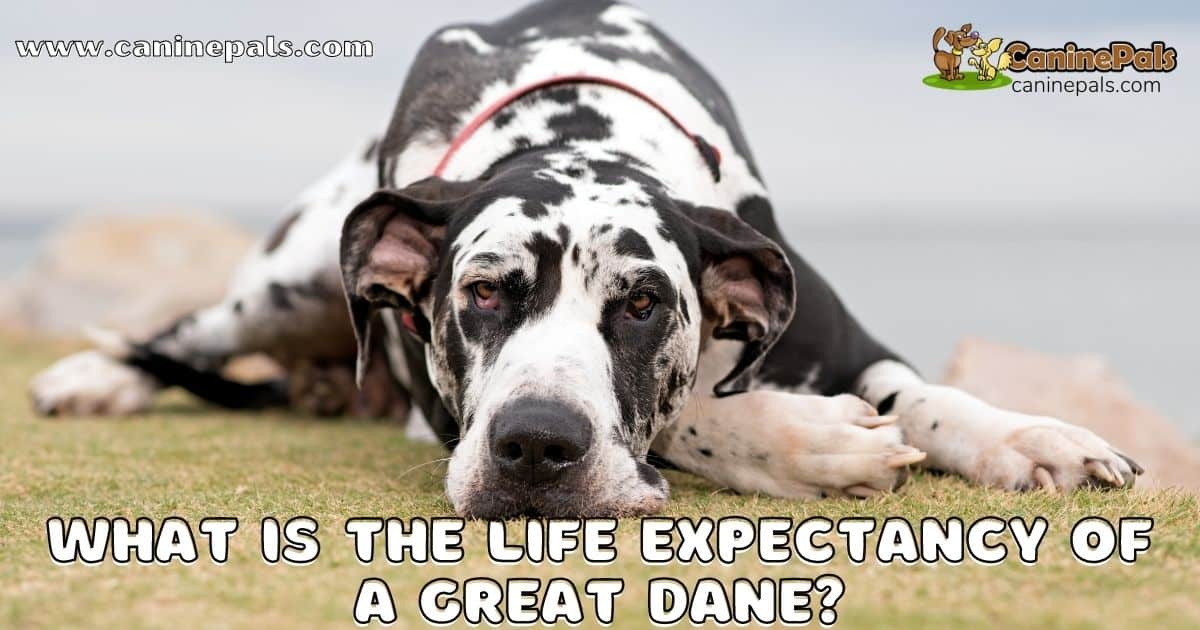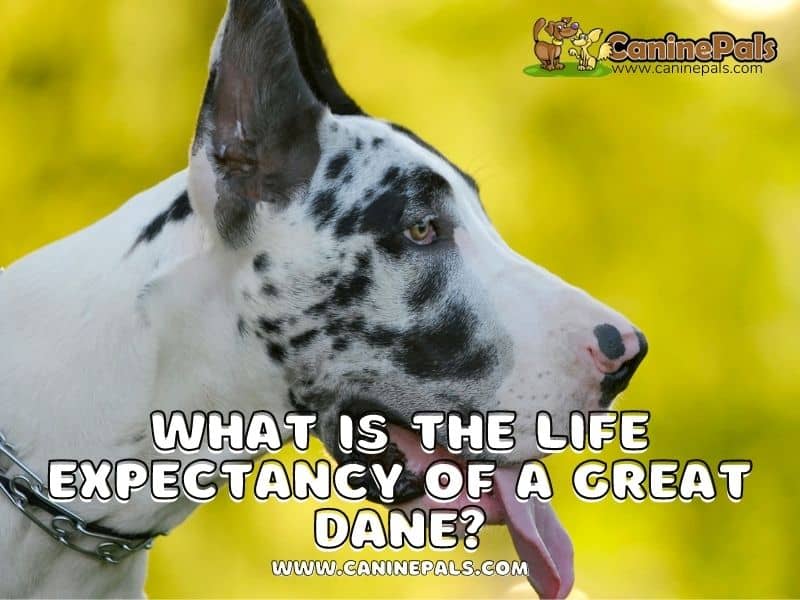Last Updated on March 20, 2024 by Denise Leo. Post first published on September 21, 2021.
Great Danes are frequently referred to as “gentle giants.” This is because they are huge dogs, but their temperament is very gentle and loving.
In the 1800s, when Great Danes were in fashion, they were a prized pet for the wealthy and royals. However, one sad fact is that the lifespan of a Great Dane is relatively short compared to other dog breeds. We’ll take a look at why a little later in this article.
The Great Dane has a lifespan of 8-10 years on average. One reason why their lifespan is short is that they suffer from health problems such as Cancer, Gastric Dilation (Bloat), and heart disease. Take your dog to the vet for regular health checks, and check it eats and digests its food properly.
Why is a Great Dane’s Lifespan so Short?
A Great Dane’s lifespan is relatively short compared to other dog breeds. The breed suffers from many hereditary diseases that are less common in other smaller breeds.
There are a number of other theories that try to explain why a Great Dane’s life expectancy is so short. Dog experts believe that because Great Danes are so large, their organs grow at a rate that doesn’t match the pace of their body growth. As their organs grow, they can put too much pressure on their heart and other vital organs, causing them to fail sooner than later.
In any case, this dog was bred as a hunting dog, so the focus was not on the Great Dane’s lifespan. Perhaps this original breeding is connected to this shorter lifespan.
Another reason for this shorter lifespan is probably genetic; they have a genetic mutation that affects the cells involved in DNA repair and replication (Fox et al., 2008). This mutation has accumulated in the breed over time, and it is impossible to change it without breeding the trait in all dogs (Lorenz & Georgi, 2017).

What are the Most Common Health Problems That Shorten the Life Expectancy of Great Danes?
An enlarged heart is one of the most common diseases affecting Great Danes. This disease is called Dilated Cardiomyopathy (or DCM), a form of heart failure. As the dog gets older, the heart muscles work less efficiently, and the heart weakens.
Some of the symptoms to look out for include:
- coughing after exercise
- breathing problems
- falling over after exerting themselves
The good news is that if caught early enough by your vet, medicines can be given to the dog to enable it to live longer. So, get your Great Dane checked out if you see any of the symptoms.
Other health problems that may shorten the average life expectancy of a Great Dane include Cancer, particularly bone Cancer, which can be a common problem in these dogs. Look out for swollen joints that give your dog some pain. Chemotherapy may be an option to help extend your dog’s life expectancy if it has Bone Cancer.
Various other types of Cancer can shorten your Great Dane’s happy life. Be sure to check for lumps on your dog and get them checked out by your vet. Here are some symptoms to look out for if you think your dog may have Cancer:
- diarrhea
- being sick
- lumps or growths on the dog’s body
- sudden weight loss
Quick action and a checkup can let your vet treat your dog and prolong a Great Dane’s life span.
Another major health problem that affects Great Danes is a cranial cruciate ligament tear. This happens when the dog’s front or hind leg puts too much pressure on the knee, eventually tearing the ligament.
This is often misdiagnosed as an injury to the bone because it will cause inflammation on the joint, which can mimic other injuries to bones. This can limit the exercise that the dog gets and shorten the length of the dog’s lifespan.
Great Danes are much more likely to get certain health problems than other dog breeds. This is because the Great Dane’s size and weight puts much more pressure on their joints and bones, which can cause pain and irritation.

Great Dane Health Issues
The following list includes some of the most common health problems that affect Great Danes:
– Hip Dysplasia: Hip dysplasia is a genetic disease that can cause inflammation in the ball and socket area of the hip joint. It often affects young dogs as they age, but it may also occur due to injury or obesity.
– Dislocated Joints: Great Danes’ large size causes their joints to dislocate more frequently than smaller dogs. This occurs when they are jumping or twisting due to their weight distribution.
A Great Dane needs a lot of exercise to maintain a healthy weight. They can be prone to stomach torsion, glaucoma, cataracts, hip dysplasia, and deafness.
One point to note about giving your Great Dane exercise is that you shouldn’t take your dog on excessive walks or hikes before it is two years old. You may risk damaging its joints before they fully develop. A dog with bad joints will probably have a shorter lifespan.
Glaucoma is a painful eye condition that can lead to blindness if not treated. It is more common in Great Danes than other dog breeds because the breed is predisposed to this condition. Cataracts are another condition that can affect a Great Dane’s eyesight but is less common than glaucoma.
Hip dysplasia causes pain and arthritis in the hip joint, as well as stiffness in the hind legs, which can lead to lameness and difficulty walking. All these disorders can not only make your dog’s life less pleasant, but they can also shorten it.
What do Most Great Danes Die of?
As we have said, it’s not uncommon for Great Danes to have cancer, heart disease, or stomach torsion. What are the most common causes of death among these big dogs?
Bloat is the number one killer, according to the American Kennel Club. This illness is caused by gas in the stomach, which, if not treated, can cause a twisting in the stomach muscles, disturb the dog’s digestion, and restrict blood flow to the heart.
This can lead to multiple complications that can radically shorten your Great Dane’s lifespan. If this occurs, your dog will most likely need medical attention and possibly surgery to help treat the problem. The most common cause of Bloat in Great Danes is eating too fast and swallowing too much gas.
Unfortunately, this health issue is passed from one generation to the next, so an owner needs to be aware of the problem and take action quickly if the dog exhibits any of the common symptoms.
Any number of factors, including genetics, environmental factors, radiation exposure, and chemical exposure can cause cancer. Cancer can also be hereditary, so if your dog’s parents both had cancer or your dog’s parents are closely related to the same dog who has had cancer, then it may be worth seeing a vet about screening for the disease.
What Is The Average Great Dane’s Lifespan?
The Great Dane’s lifespan is only about 8-10 years. This is considerably shorter than other dog breeds, which usually live for 10 to 13 years and, in some cases, even 15 years.
As a former dog owner, I have experienced the death of two dogs, and this is an extremely sad event in anyone’s life. I was lucky enough to own a Cocker Spaniel, who lived for 13 years, and a Labrador Retriever, who lived for 16 years. They both seemed to be relatively short periods because we, as humans, live much longer.

Great Dane Versus Other Dogs’ Life Expectancy
On average, a Great Dane can live 7 to 10 years. But a Dachshund, a Maltese, and a Chihuahua can live more than 20 years, a German Shepherd 15 years, and a Beagle 13 years. Why is there such a difference in average life expectancy for these dog breeds?
Many factors affect the average life expectancy of a dog breed. The most obvious one is the Great Dane’s overall health. Another issue is size. The bigger the dog, the shorter his life expectancy will be. This is generally the rule. Bigger dogs, like the Great Dane, live for a shorter time because larger dogs age faster than many small-breed canines.
Another factor that affects longevity is genetics. Some dog breeds have been bred to have specific qualities, which sometimes creates health problems, while others are more well-known for their vitality and healthiness. There’s nothing that can be done about this.
Because many Great Danes can face problems that can become fatal, it is a good idea to check the medical history and background of the puppy and its parents when purchasing a puppy to ensure that you are buying a healthy and well-bred dog.
This will not remove the risks of the breed but may give you peace of mind and ensure that you will enjoy as many years as possible with your new prized pet.
How Can You Help Your Great Dane Live Longer?
Many factors can determine how long a Great Dane lives. For example, the dog’s gender and diet will influence its lifespan. However, there are several things an owner can do to give their dog a healthy life and a longer life span.
The best thing you can do to keep your Great Dane healthy for as long as possible is to ensure they have a healthy diet. Please pay attention to what they eat and drink, not let them get too cold or hot, and give them lots of daily exercise.
One thing you can do is take them for regular walks. The more exercise they get, the healthier their heart will be, leading to longer life. This is because exercise improves blood flow and reduces the risk of heart disease.
Another thing you can do is feed them healthy food. This means avoiding foods with too much fat since they contribute to weight gain and obesity, which leads to an increased risk of diabetes and high blood pressure. You should also consider giving them a chew bone or other chew toy to keep their jaws strong and reduce the risk of dental problems like periodontal disease, which can also lead to death if not treated in time.
Prevent Your Dog From Developing Bloat
To help prevent Bloat, the best practice is to feed your dog smaller portions and spread them throughout the day rather than give them one or two larger meals they may wolf down. This should reduce any potential problems with gas or digestion and avoid emergency surgery.
Another good idea to slow down the eating of your Great Dane is to use one of the special dog bowls made for this purpose such as a JASGOOD slow feed dog bowl. This is a great way to reduce gas from fast eating.
Great Danes Live Longer With Correct Care
Another important thing to consider if you want to extend your dog’s life expectancy is to try as far as possible to keep your dog happy, and this includes giving it proper care, love, attention, and exercise. Help reduce many issues, treat your Great Dane as one of the family, and take care of your valuable pet, as his years are usually more limited than other dogs.
Did you realize that brushing your dog’s teeth can actually prevent disease and help your Great Dane live a longer and healthier life? According to the Animal Health Center, cleaning your Great Dane’s teeth can prevent dental disease from affecting the liver, kidneys, heart, and joints, all weak points in this breed’s body.
If the disease takes hold in any of these areas, the results can be serious for your dog. So clean your dog’s teeth daily to help it stay healthier and live longer.

About the Great Dane
The Great Dane is believed to have appeared on Egyptian monuments dating back to 3000 B.C. His written description was first found in 1121 B.C. in Chinese literature. His ancestors included the old English Mastiff and Irish Wolfhound, which the German people developed to hunt boar. When he wasn’t needed for hunting, he became a good companion and guard dog of family estates.
He’s sometimes called a “gentle giant” or “the king of dogs.” He’s strong and big but has an energetic, friendly personality. His coat colors can be blue, harlequin, black, fawn, brindle, and mantle. He needs to be supervised when he’s around small children. He needs daily walks. His short coat doesn’t require much grooming. He stands at least 30 inches high.
Final Thoughts on the Life Expectancy of a Great Dane
The average lifespan for a Great Dane dog is 8-10 years. However, the life expectancy of this large dog breed varies depending on its health and many other factors, such as the environment and genetics.
Unfortunately, great Danes, one of the largest dog breeds, have shorter lifespans than many other breeds. The average lifespan of a Great Dane underscores the reality that giant dogs often lead shorter lives, a fact that is particularly true for large breeds and purebred dogs.
Despite their majestic appearance and gentle nature, these loving giants are prone to heart diseases and other health issues contributing to their short lifespan. However, owners must focus on the most important things they can offer these dogs: a proper diet, adequate care, and a loving environment.
Owners can significantly impact Great Dane’s quality of life by providing high-quality dog food for large-breed dogs, ensuring regular veterinary check-ups, and creating a strong bond through daily interaction.
Although their time with us may be brief in dog years, the memories and affection shared with these gentle giants can leave a lasting impression on adults and young children, teaching them about love, loss, and the special role pets play in our lives.
Please note: while I do discuss health, care, and behavioral issues, you should never use this information as a replacement for advice from qualified veterinarians, diagnoses, or recommended treatment regimes. If you have any worries about the health of your Pomeranian, your first contact should be your regular vet or, if you don’t yet have one, a vet that works locally. Never ignore or avoid treatment and advice from your vet because of a piece of information you have read on any website.
Copyright CaninePals.Com. All Rights Reserved.
References and Further Reading:
[1] American Kennel Club, Great Dane Information.


